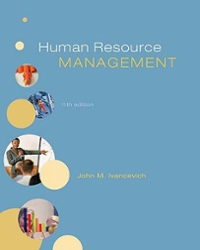E-recruiting has evolved as a popular means of addressing the shortcomings of traditional print advertisement. Web sites
Question:
E-recruiting has evolved as a popular means of addressing the shortcomings of traditional print advertisement. Web sites like Monster.com and CareerBuilder.com are used by thousands of companies as a way to post job openings. However, maybe HR personnel need to ask whether e-recruiting works too well. How Many Applicants Do I Have?
The goal of recruiting is to develop a pool of viable applicants. As this pool moves from small to large an organization's ability to be selective increases and nearly every HR textbook will suggest that the larger the applicant pool, the better. The logic behind this desire is undeniable. If only a few candidates apply for a position the organization may be limited to hiring a minimally qualified individual. With 10 or 20 applicants for a job, employers may be much more selective seeking out specific applicant qualities associated with success. Is there a point however, when an organization receives too many applicants? For example, in one year, Lockheed Martin received 300,000 résumés from which it filled 900 positions; this equates to over 330 résumés for each opening! While in many ways this is a good problem, it is still a problem. Screening this quantity of applicants down to a manageable level can present a significant burden. Some organizations apply automation to this process through the use of content reading software. Other organizations sort applicant résumés and applications by hand. Neither result is error-free and can result in the organization disqualifying viable candidates. If certain groups of candidates are disqualified at a disproportionately higher rate than other groups, then there may be potential legal implications for the hiring organization.
Did These People Even Read What the Job Is?
One of the key advantages of e-recruiting is that it is easy for individuals to apply. Applicants typically do not have to compose cover letters or print résumés; nor do they have to add stamps or drop them off at the post office to mail. The cost to apply for a position may simply be a few key strokes. This ease may induce individuals that are marginally qualified or have minimal interest in the posted position to apply. Survey results published in HR Magazine
support this point as they list that a leading concern among e-recruiters is the ability to attract high quality applicants. Marginally qualified applicants add to the recruiting clutter and may obscure better candidates. Increasing the time required to complete an online application may help dissuade casual inquiries; however, legitimate applicants may also be put off by what is perceived as overly demanding online procedures. Organizations should decide whether to raise the time cost associated with applying online or focus on more efficient ways to sort through the burgeoning numbers of online applications.
Questions
1. Given the competition for job candidates on the Web, what elements would you
recommend for an e-campaign that would make a job posting stand out?
2. Would you recommend Web-based recruiting to an organization wishing to hire locally? What are the advantages and disadvantages?
3. What systems would you recommend to an organization to prevent inappropriate content from reaching the Web? How can an organization balance the desire for speed of action to the need for legal protection?
Step by Step Answer:






